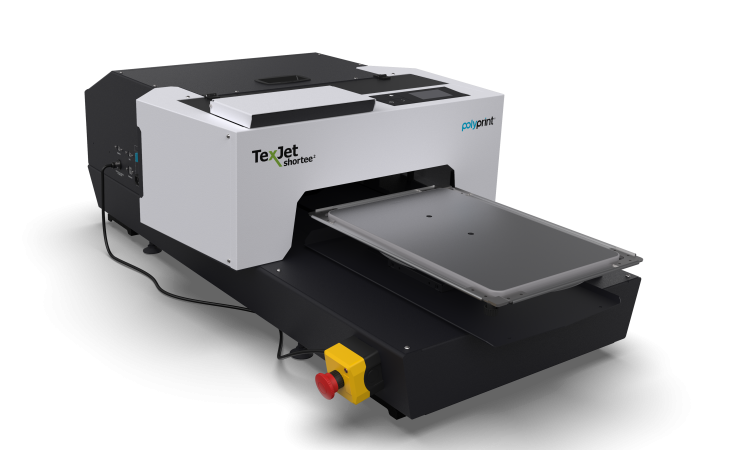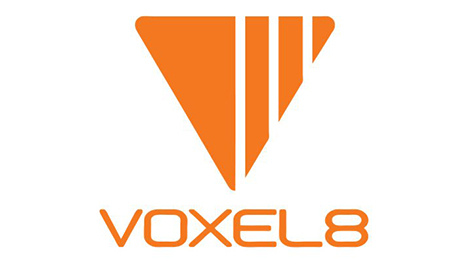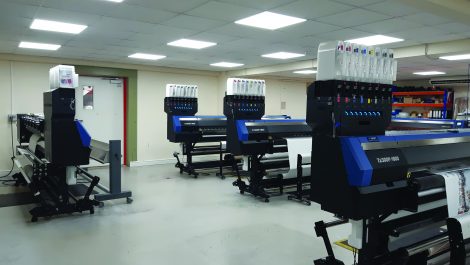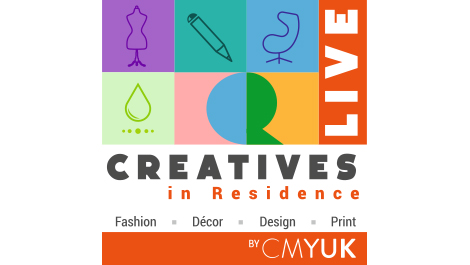Over the last few months Digital Textile Printer has kept trumpeting that now is the time to explore textile printing, but it’s no use us doing that if we don’t help you explore the options available when it comes to entry-level textile printers. So what we’ve done is reach out to some of the biggest names in the sector and asked them all about their entry-level machines, gathering all the information you might want in one place.
Of course textile printing is hardly one thing – wallpaper, signage and fashion; dye-sublimation, transfer printing and direct-to-garment… all these and more fall under the umbrella, so we decided to let each company define ‘entry-level’ on their own terms and decide which of their machines to put forward for this article.
As a result you’ll find wide-format behemoths jostling for space with desktop options costing only a fraction of the price, but what better way to make sure that everyone, from big companies looking to diversify through to one-man bands looking to start their own businesses, finds out what they need to know?
DURST
ALPHA SERIES (190 and 330)
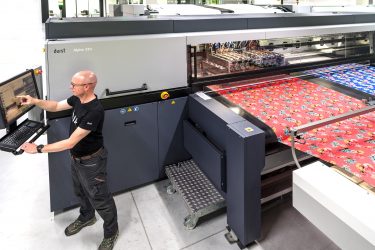
Primary application(s)
Industrial textile, soft signage and wallpaper printing
Key features
Print speed: 1500sqm/hr
Resolution: 600dpi
Inks: pigment, reactive or dye sublimation ink
Colours: eight (CMYK with special colours depending on ink type)
Print area: TBC
Price
Durst didn’t provide figures, however the price is reportedly in six figures
Number of installations
No information available
USP
‘The combination of image quality, speed and reliability is unmatched, rendering it the preferred choice for quality-demanding customers with high productivity needs.’
Why should people consider textiles?’
‘(With) disrupted supply chains, a strong trend for globalisation, an e-commerce boom and local funding initiatives, this is the perfect timing for investing in digital textile printing.’
Durst’s key advice
‘Go for a partner that offers an integrated solution. Within Durst, this is referred to as the ‘pixel-to-output approach,’ as we offer not just machines, inks and service, we also provide top-quality customer support with our TAC team as well as latest software.’
EPSON
SureColor SC-F100
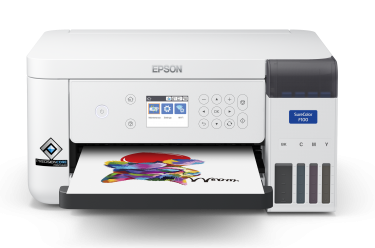
Primary application(s)
Promotional and personalised gifts
Key features
Print speed: A4 sheets printed in 65 seconds
Resolution: 660 x 1200dpi
Type of inks: dye sublimation ink
Colours: CMYK
Machine size: 375 x 347 x 187mm
Price
£349 + VAT
Number of installations
Epson doesn’t publish installation numbers, but assured us that, ‘since the launch demand has outstripped supply.’
USP
‘At less than £400 the SureColor SC-F100 dye enables a highly cost effective first entry into the market with A4 size prints. In addition, the price per ml is significantly lower than cartridge equivalents due to its refillable ink, so running costs are extremely frugal.’
Why should people consider textiles?
‘While some sectors like photo and proofing struggled in 2020 others saw strong growth particularly textile and promotional goods where the trend towards personalisation and customisation accelerated.’
Epson’s key advice
‘Invest in easy-to-use, reliable systems that make high quality production simple. That way you can be up and running quickly to maximise profitability.’
KORNIT
Storm HD6
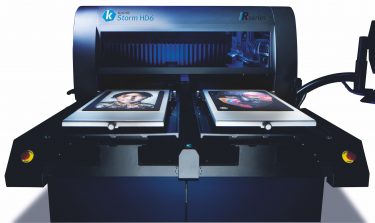
Primary application(s)
Used to imprint apparel and textile accessories including cotton, polyester, cotton-poly blends, lycra, viscose, silk, leather, denim, linen, wool.
Key features
Print speed: 55 dark or 68 light garments per hour
Resolution: 1200dpi
Type of inks: proprietary Kornit NeoPigment inks exclusively
Printable colours: CMYKRG + White
Machine size: 290 x 202 x 165cm (weight is 1705kg)
Print area: 50 x 70cm
Price
Undisclosed, but described by Kornit as, ‘a significant capital investment.’
Number of installations
‘Hundreds across the world.’
USP
‘This printer features inline pre-treatment (a Kornit-exclusive capability for DTG), which minimises the steps/labour required to imprint each piece.’
Kornit’s key advice
‘Consider scalability. Invest in technologies and strategies that offer agility and versatility, because you don’t know how the marketplace will change. The pandemic economy swallowed many businesses that were hamstrung by outdated production technologies, forecast-based (rather than on-demand) business models, and reliance on revenue streams that disappeared overnight.’
MIMAKI (answers provided by partner Hybrid Services)
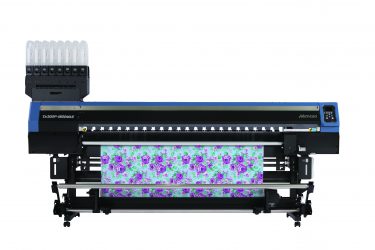 1) Tx300P-1800MkII
1) Tx300P-1800MkII
Primary application(s)
‘Ideal for businesses looking to deliver a varied range of applications, such as fashion, sportswear, soft signage, décor, furnishings and flags – in fact, it is possible to print to almost any natural or man-made fabric.’
Key features:
Print speed: up to 66sqm/hr
Resolution: up to 1440dpi
Type of inks: sublimation, pigment, disperse or reactive
Colours: up to eight per inkset
Size: maximum media width 1950mm
Price
£27,995 (includes Mimaki RIP software and a two-year warranty)
Number of installations
Information not provided
USP
The Mimaki Tx300P-1800MkII offers the versatility of running two ink sets, which affords ‘unparalleled flexibility for print companies, designers, universities and bureaus to offer a broad range of products, unconstrained by ink type.’
2) TS100-1600
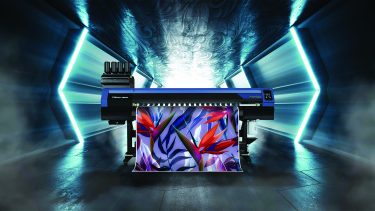
Primary application(s)
‘Prints to transfer paper for sublimating to polyester materials. These include sportswear, fashion and accessories, soft signage and lightboxes, furnishings and décor as well as output to incorporate into rigid products such as polyester coated signboards, plaques, mugs and promotional items.’
Key features
Print speed: up to 70sqm/hr
Resolution: up to 900dpi
Type of inks: Mimaki Sb610 sublimation ink
No of Colours: CMYK
Size: maximum media width 1620mm
Price
£9,995 (includes Mimaki RIP software and a one-year warranty)
Number of installations
Information not provided
USP
‘Offered at an entry-level price yet with an incredible maximum speed of 70sqm/hr, the TS100-1600 sets a new standard for printing sportswear, apparel, furnishings, soft signage and more.’
How would you define entry-level when it comes to textiles?
‘For some it will be as simple a definition as ‘their first textile printer’ – however they could often be experienced printers looking at expanding into the realm of fabric printing. Equally, businesses could be moving up from a desktop solution, looking to increase productivity and reduce costs by upgrading to a wide-format model.’
Why should people consider textiles?
‘The personalisation market is booming – with the web-to-digital print sector performing very strongly, as distanced families and friends gift customised presents, furnishings and prints. Equally, the demand for bespoke fashion and décor continues to grow, with consumers enjoying the opportunity to style important areas of their lives.’
Hybrid’s key advice
‘Explore the potential to offer wide ranging products to your existing customers!’
POLYPRINT
TexJet Shortee
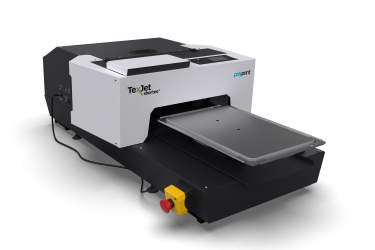
Primary application(s)
T-shirts, denim, tote bags, canvas shoes, bedlinen, babywear, sportswear, hats, petwear, professional clothing, fashion accessories and promotional items.
Key features
Print speed: 20 dark or 45 light garments per hour
Resolution: 1200dpi
Type of inks: water-based textile inks
Printable colours: CMYKRG + White
Machine size: 110 x 67 x 42.5cm (weight 68kg)
Print area: 30 x 45cm
Price
€8495 (approximately £7250)
Number of installations
Undisclosed
USP
‘TexJet printer users can now print direct-to-garment and direct-to-film with exactly the same printer and exactly the same ink setup. They also have one of the smallest ink drop sizes (3pl) in the market, producing sharp design details and photorealistic prints.’
Why should people consider textiles?
‘The rise of e-commerce, the need for short, cost-efficient, production runs and on-demand printing, as well as the drive to remain eco-friendly has boosted direct-to-garment printing.’
RICOH
Ri100
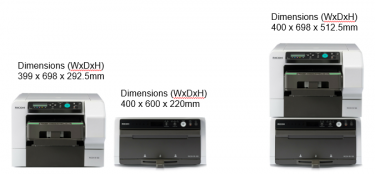
Primary application(s)
T-shirts, tote bags, baby grows, polo tops, cushions and non-medical face masks.
Key features
Print speed: 80 – 180 seconds depending on image size
Resolution: 600 x 600dpi in fine mode or up to 1200 x 1200dpi in vivid mode
Type of inks: water-based pigment inks
Printable colours: CMYK onto white or pastel garments. It can also print black only onto coloured options.
Machine size: various depending on configuration (see image)
Print area: 291 x 204mm
Price
£2,995 + VAT (includes printer, curing oven, delivery, a full set of standard size ink and design software.)
Number of installations
‘Hundreds across Europe.’
How would you define entry-level when it comes to textiles?
‘When we talk about an entry level device like the Ri 100 we are referring that the user needs no special skill sets to operate the device and produce a print. You do not need to have a degree in design or computers to start printing items. The device will also require less maintenance that larger, more commercial models. If you can print on a piece of paper, you can print on the RicohRi100.’
USP
‘It’s a complete business in a box and no other equipment (apart from a laptop/computer) is required to start your DTG journey. This is a desktop-sized device that is stackable at a low risk price allowing most people to enter the market with very few concerns or worries.’
Why should people consider textiles?
‘Direct-to-garment printing is becoming increasingly popular and numbers of garments produced by this technology is rapidly on the rise. In 2019, 372 million T-shirts were produced with DTG Technology, in 2024 this number is expected to get to 720 million-plus. Now is the perfect time to look into this technology and enter a market that is only getting bigger and better.’
Ricoh’s key advice
‘You need to understand what market are you after, who are your customers, how will you sell to them, what will you charge them, how much time do you have to make/print them et cetera. Once you know the answers to questions like this you can start to build the business model.’
Roland
VersaStudio BN-20
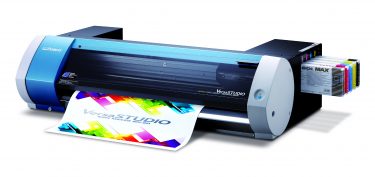
Primary application(s)
Roland says ‘the BN-20 is easily the most versatile print device in its class. Perfect for creating vinyl transfer graphics for t-shirts, apparel, tote bags, interior decor items and more.’
Key features
Print speed: TBC
Resolution: 1440dpi
Type of inks: Roland Eco-Sol Max3 in 220cc cartridges
Printable colours: five, CMYK and either metallic silver or white
Machine size: 1009 x 582 x 293mm (Weight of 36kg)
Print area: 150 – 515mm width
Price
£5,199
Number of installations
Over 1000 in the UK
How would you define entry-level when it comes to textiles?
‘Most entry-level products are purchased by entrepreneurs in the early days of setting up their print business, and therefore should be simple to use and allow for a quick return on investment. Moreover, entry-level machines should allow for a wide variety of complementary applications so that the investor has more opportunities to support the growth of his business in different areas.’
USP
‘The VersaStudio BN-20 is Roland DG’s most compact and affordable printer/cutter and packs everything into one powerful, profit-producing package in the smallest possible space. As a result, it is perfect for small stores and temporary spaces, letting users jump-start their personalised printing business with a small initial investment.’
Why should people consider textiles?
‘The demand for personalised or branded goods has held strong over the past year and, in some cases, has even increased. During the pandemic, customers have become used to making purchases online, where everything is at their fingertips: as a result, the big winners we’ve seen are those that have embraced digital technology and e-commerce to provide personalised goods such as apparel to their customers.’
Roland’s advice
‘The personalisation market is constantly evolving as buyers’ habits change, so rather than focusing on specific items, newcomers should start with a flexible approach. It is best to research competitors and similar businesses, but always be prepared to try something different and think outside the box. For example, both the commercial and consumer interior décor markets are projected to see an increased demand for personalised wall coverings and graphics – which could be an excellent entry point for wide-format print companies.’
